Take it from someone who has spent the last few years building a profitable online course:
The right online course platform can make or break your business.
I’ve spent hundreds of hours researching the best online course platforms, and trialling them with my own content, to find which are the best and the worst on the marketing right now.
In this guide, I’m going to walk you through 17+ best online course platforms, along with our top 5 choices, so you can find the right combo of pricing, features, and engagements tools for your business.
Thinkific
Create, market, and sell your expertise with a single platform that gives you total control of your brand and business.
Kajabi
Create courses that attract premium prices. Create coaching programs, membership sites, podcasts, and more.
Teachable
With an easy-to-use online course platform, Teachable turns your expertise into a booming business from anywhere in the world.
Learnworlds
Engage learners with interactive videos, ebooks, assessments, certificates, SCORMs, surveys, and much more.
We’re reader-supported. When you buy through links on our site, we may earn an affiliate commission.
Who am I and why should you trust these reviews?
My name is Adam Enfroy and I run Blog Growth Engine, a course that makes about $3 million a year. And, honestly, my income would be a lot lower if it wasn’t for the right tool.
Online education is changing rapidly, and if you want to make money selling your own knowledge, choosing your tool is one of the first steps, so good job. 🙂
If you’re unfamiliar with these online learning platforms, these are browser-based platforms that help you:
- Create an online course website (or integrate your course with an existing site).
- Build sales landing pages.
- Upload your videos, add assignments and quizzes, create interactive content, and engage with your students.
- Create membership communities.
- Host live webinars.
While online education has advantages and disadvantages, the best online course platforms can ensure that both teachers and students get the most out of the online experience.
Listen while you read: After our genuine and honest testing, here’s a video with our top 3 online course platforms and a preview of their dashboards:
Video created by AdamEnfroy.com and Codeless.
Let’s get started.
What Are the Best Online Course Platforms?
Here are my top picks for the best online course platforms this year.
- Thinkific.
- Kajabi.
- Teachable.
- Learnworlds.
- Podia.
- Skool.
- Mighty Networks.
- LearnDash.
- Ruzuku.
- Academy of Mine.
- WizIQ.
1. Thinkific.
Best Overall Online Course Platform (Free or $49/mo)

Adam’s Take
I love Thinkific and use it for my online business, selling my course Blog Growth Engine. They provide an excellent student experience, easy integrations with Stripe and checkout providers to make collecting payments easy, and they have an expert support team that’s been super helpful. Overall, I recommend Thinkific wholeheartedly as my #1 recommendation for selling online courses.
Thinkific is the best overall platform to sell online courses.
It’s my #1 choice because the pricing is precisely in line with other affordable options on this list, and it can deliver a high-end course experience.
- Course websites can be customized, and you’d never guess they were Thinkific.
- Sales pages are highly optimized and look great.
- Student dashboards look nice and are customizable (you can add videos, text, and any downloadable file type to the same page).
- You can send your entire course at once or drip it out over time.
- Free Wistia video hosting (an immense value).
That’s honestly all that you need for an optimized course website.
Even though Thinkific plans start at just $49/month, huge brands like Fiverr use Thinkific to sell online courses.
I would have never guessed that this massive learning database was a Thinkific site until their team told me:

Their best (and most popular) Pro Plan offers a one-month free trial to get started.
First, this plan gives you the ability to create unlimited courses. It also features memberships and bundles, advanced pricing options, landing pages, certificates, and marketing tools.
Here’s a little preview of the experience of creating a Thinkific course.
All that you do is create and customize your course with their drag-and-drop editor:
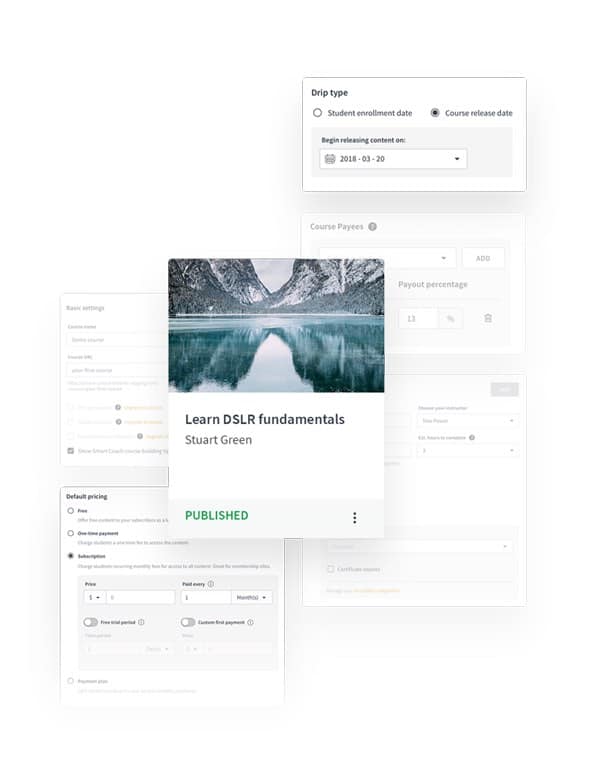
Next, you upload your content and choose one of their website templates:
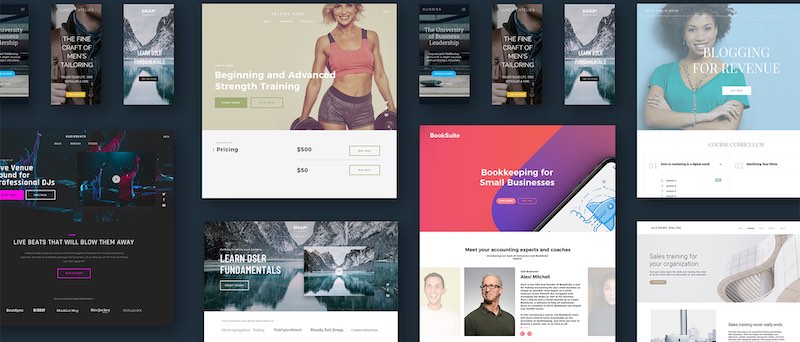
Lastly, you set up payment methods (you can collect payments in over 100 currencies):
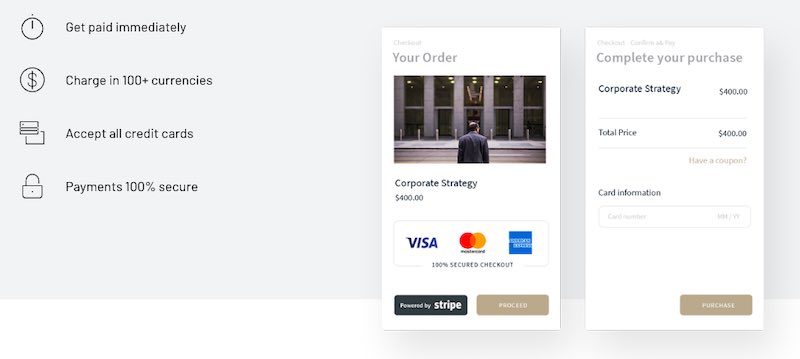
There are also a ton of customization options. If you want to build a completely custom site, their onboarding team takes your vision and helps you turn it into a reality.
Here’s what people are saying about Thinkific:
- “You need to get on Thinkific. The team is creative, reliable, and offers unbeatable support. They always make sure all my bases are covered and, as a business owner, that’s invaluable.” – Lewis Howes.
- “We’ve grown ours by teaching our audience how to scale and grow their business through online training. We couldn’t have done it without Thinkific.” – John Lee Dumas, Entrepreneurs on Fire.
- “I seriously can’t be more impressed with your customer support team. They are the perfect blend of efficient and personable. It’s like having my very own IT department.” – Kim Garnett.
Key Features:
- Live Lessons & Cohorts allow you to deliver your course content live, in real-time, to students worldwide.
- Advanced customizations mean making your courses look and feel precisely how you want them to.
- Website themes help you quickly and easily create a professional-looking website without any design or coding experience.
- Communities & Memberships allow your students to connect and learn in collaboration.
- Progress Tracking lets you see how your students are doing and identify any areas they may need help with.
- Assessments & Certificates allow your students to demonstrate their understanding and progress.
User Interface:
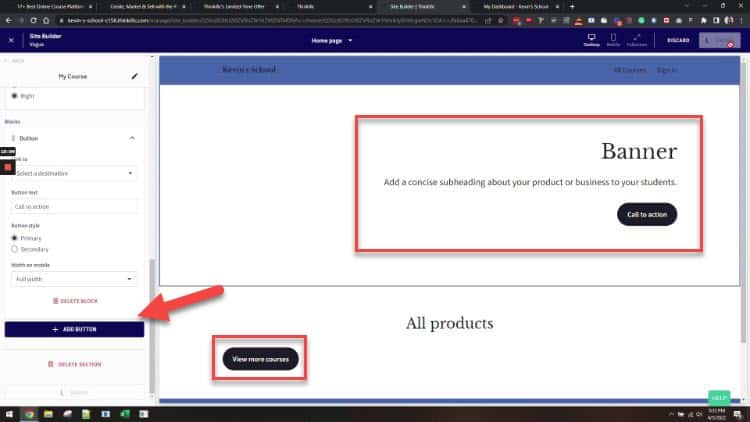
Configuring your course landing page is one of the many benefits of using Thinkific.
You can use their built-in landing page editor to easily customize the look and feel of your page without having to know any code!
There’s also a wide range of course templates that you can choose from, so you can find one that fits the style of your course.
From pre-selling your course to creating a mini-course, hosting a webinar reply, and more, Thinkific has you covered.
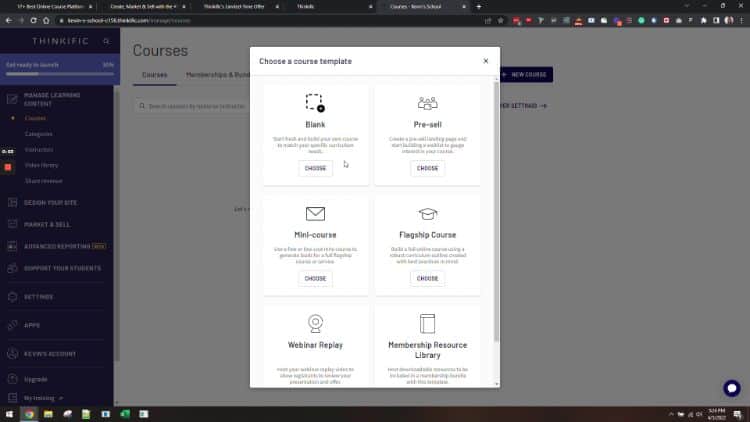
Thinkific Pricing:
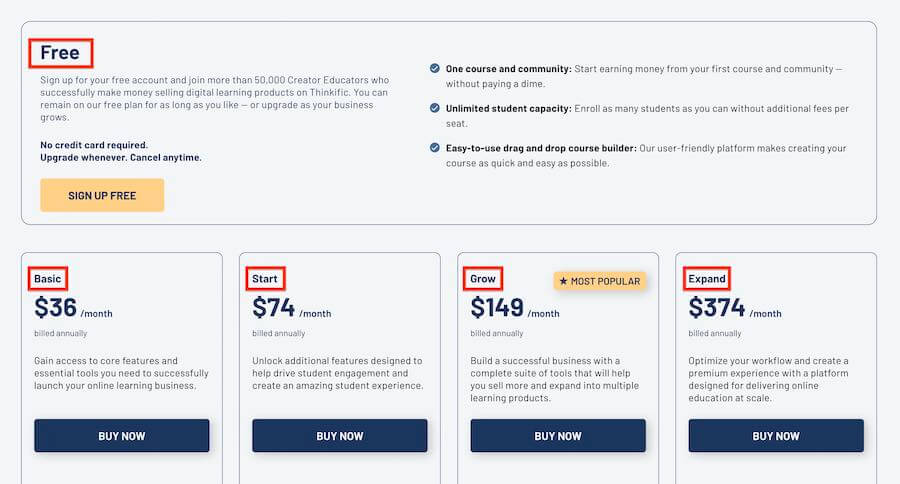
- Free ($0/month): Great to test out the features and get a feel for the interface.
- Basic ($36/month): Unlimited courses and students, 1 administrator, drip (scheduled) content, custom domain, email integrations, and coupons.
- Start ($74/month): Basic features, 1 administrator, plus memberships and bundles, private courses, certificates, advanced HTML and CSS editing, assignments, live lessons via Zoom, and priority support.
- Grow ($149/month): Pro features, plus 3 administrators, onboarding package, and unlimited growth package (best for big teams).
- Expand ($374/month): Pro features, plus 5 administrators, onboarding package, and unlimited growth package (best for big teams).
What I Like/Dislike About Thinkific:
Like:
- Marketing automation and email features.
- Simple free plan to get started.
- You can fully edit the code of your course site.
- Customizable course certificates.
- Custom domains.
- Affiliate marketing help and reporting.
Dislike:
- There’s a slight learning curve to the setup.
- Integration with social media networks and CRMs would be a nice touch.
Product Updates:
- Thinkific Payments allows you to have a faster performance checkout page, reducing the dropoff rate. This means that you can keep more of your hard-earned money!
- Integrated order bumps functionality means that the average order value on your Thinkific site can be increased by offering a small add-on product at checkout.
Overall, I recommend the Thinkific platform as my #1 choice for course creators and entrepreneurs who are serious about creating, marketing, and selling their own course content.
With my link below, you can get started today with a one-month free trial of their Pro Plan.
2. Kajabi.
Best High-End Online Course Platform for Professionals ($119/month)

Adam’s Take
Kajabi is one of the best platforms for professionals wanting to scale their businesses. With so many features in their plans, you can develop your online training just as you want and build as many features within your platform as needed. Whether you want to send newsletters, host podcasts, or build membership sites, Kajabi can work for your needs.
Kajabi is the best high-end course builder tailored toward information business, not tiny course creators.
It’s best when it comes to email marketing automation. Automation is a crucial component of pre-sale, pre-webinar, drip course, and upsell emails – and Kajabi does it best.
Their “Pipelines” feature lets you create fully-automated marketing campaigns and funnels. These are pre-built frameworks for lead generation, with pre-written copy optimized for conversions.
It also features powerful course site themes, the ability to sell digital products, a customizable checkout, and blogging functionality.
Overall, it’s the best high-end course platform with more built-in tools and features, but it costs a little more than others on the list.
Key Features:
- Course insights that give you a clear picture of how your students are doing
- Unlimited video hosting so you can create as many courses as you want
- Publish quickly to your website with just a few clicks – no need to learn to code!
- SEO-optimized so your courses show up high in search engine results
- Unlimited hosting for your classes and marketing materials
- Safe and secure, so your data is always protected
- One-click marketing sequences make it easy to promote your courses
- Website builder lets you create a professional website in minutes without any design or coding experience required
User Experience:
Regarding the user experience of using the platform for the first time, Kajabi is quite intuitive with where you have to click.
You can follow the instructions to create mini-courses and evergreen training, build your community, set up your membership site, and much more.
This makes it easy for new users to get started with the platform.
However, one downside is that the interface can be a bit overwhelming with all the available options and features.
This might take some time to get used to if you are new to using Kajabi.
I also like that the settings are grouped in various groups, allowing easy access to just the right options when you need to change something.
Kajabi Pricing:
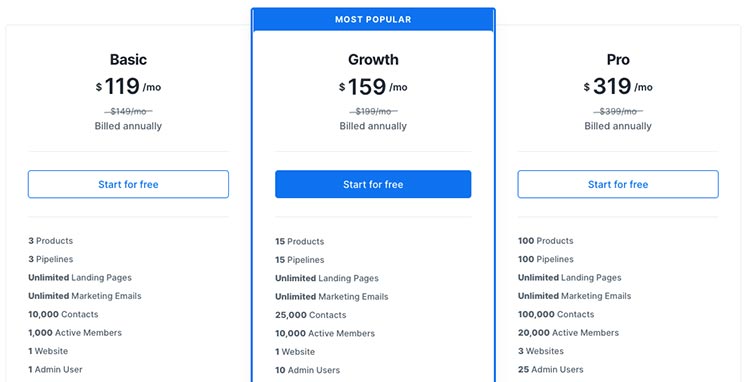
Kajabi pricing is mainly based on the number of courses and active members you have:
- Basic ($119/month): 1 website, 1 admin, 3 products, 3 pipelines, 10,000 contacts, and 1,000 active members.
- Growth ($159/month): 1 website, 10 admins, 15 products, 15 pipelines, 25,000 contacts, 10,000 active members.
- Pro ($319/month): 3 websites, 25 admins, 100 products, 100 pipelines, 100,000 contacts, and 20,000 active members.
What I Like/Dislike About Kajabi:
Like:
- Best all-in-one software for a proper information business.
- Wistia video hosting is excellent.
- Primary focus on sales and marketing tools.
- More built-in tools than other platforms.
- Can offer monthly recurring subscriptions.
- Integrated with Stripe and PayPal.
- Big names use Kajabi, including Amy Porterfield.
Dislike:
- Email sequences can be more varied.
- Some improvement on the landing page builder would be welcomed.
Product Updates:
- Carousel modules in the Kajabi website builder mean you can quickly and easily create a responsive website on any device.
- Kajabi University got a new look and feel, so it’s even easier to learn and use Kajabi.
- The user experience of Kajabi payments was revamped, making it super simple to accept payments and manage your finances.
Where Kajabi excels is in its marketing automation tools.
You can segment users in your list, send emails at specific times based on advanced triggers, and send professionally branded messages.
If you’re an established business and want to try one of the more advanced platforms on the market, Kajabi is a solid choice.
Start your free 14-day trial of Kajabi today.
3. Teachable.
Best Online Course Platform for Beginners ($0-$249/mo)

Adam’s Take
Want to sell any of your digital work online? Podia is a platform to consider. With the ability to sell online courses, and digital downloads, host webinars, and even build a community, Podia is a platform that can adapt based on your needs.
Teachable is an option if you want a fast and easy course builder.
I consider it the best for beginners getting their feet wet in the course world, as it’s one of the cheapest and easy to use.
You can use their free plan (with $1 + $0.10 for all transactions) or select one of their three plans ranging from just $29/month to $299/month.
I recommend their most popular Pro Plan at $99/month as it’s the first with zero transaction fees.
Teachable also gave me a unique and limited-time promo code (200 left):
Use PROSOCIATE1MFREE at checkout to get free one month of their Pro Plan.
Key Features:
- Bring on the authors that will help you create content for your courses. With Teachable, anyone can become an instructor and share their knowledge with the world.
- Create gorgeous, money-making sales pages that will help you sell your courses. Teachable makes it easy to design a page to convert browsers into buyers.
- Use payment providers that are PCI level-1 compliant, so you can rest assured that your data is always safe and secure. Teachable takes care of all the behind-the-scenes work so you can focus on what’s important: teaching your students.
- Use their domain to connect to your own, or use Teachable’s built-in domain immediately.
- Talk to your students live, and schedule and host webinars from your Teachable account. Engage with your learners in a whole new way.
- Schedule and host online courses that work with your busy lifestyle. Teachable makes it easy to find the time to teach.
User Experience:
The user experience is excellent on this platform.
You can easily choose your objective, including creating your own course, choosing a topic, or building an audience.
This structured approach makes it simple to follow as you create your course.
You can also customize the look and feel of your courses with a few clicks.
There are also several tutorials that show you how to use the different theme features on the site.
Teachable Pricing:
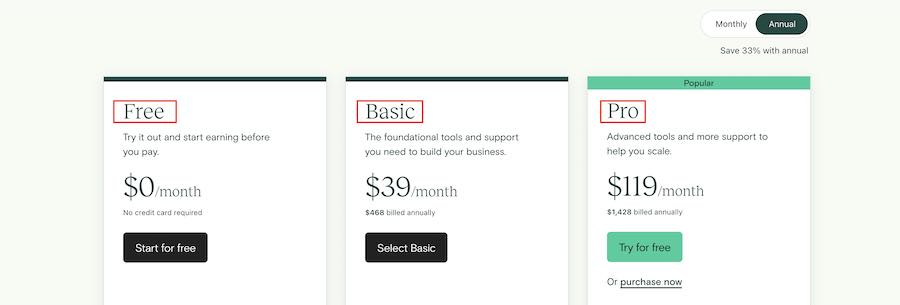
- Free ($0/month)
- Basic ($39/month): 5% transaction fees, 2 admin users, drip content, course builder, members-only community.
- Pro ($119/month): Basic features, plus no transaction fees, 5 admin users, advanced reports, and course certificates.
What I Like/Dislike About Teachable:
Like:
- Straightforward setup.
- Unlimited everything – as a coaching platform, it offers unlimited bandwidth, students, courses, and coaching services.
- One-click checkout.
- Optimized storefront and sales pages.
- Live Zoom courses on their pro plan.
- International payment plans in 130+ currencies.
- Graded quizzes.
- Custom course completion certificates.
- Website theme customization.
- They can have 5 user accounts on their pro plan.
Dislike:
- Support for individual cases is not dealt with in the same way as general platform issues.
- Website navigation is difficult to get used to at the start.
Product Updates:
- Course templates called ‘Simple’ and ‘Colossal’ were added to help you quickly create beautiful courses without any design or coding required.
- You can add lead capture forms directly to product pages, allowing you to grow your email list and increase conversions.
- Bundle functionality was added, so you can create a course package and offer it as a one-time purchase or subscription.
Get started with your Teachable Pro Plan and use my promo code PROSOCIATE1MFREE at checkout to get one month free.
4. LearnWorlds.
Best Course Creation Software for Interactive Learning ($24/month)

Adam’s Take
I think LearnWorlds is one of the best course platforms for interactivity. If you’re looking to give your students an engaging course, with quizzes, interactive videos, surveys, and certificates, LearnWorlds is a good choice. While it doesn’t have the ease of use of Thinkific, it does have strong student community features.
Best For
Interactive Learning
Price
$24-249/month
Annual Discount
Yes – Save 20%
Promotion
LearnWorlds is a platform that’s best for course creators looking to interact in unique ways with their students.
Think quizzes, gamification, interactive videos, etc.
While the student experience isn’t as nice looking as a Thinkific course, it’s unique in that it offers students more interactive eLearning content.
Key Features:
- Get tons of help when you need it from the Learnworlds team. You can access walkthrough videos, how-to articles, and even live chat with our support staff.
- You can easily create a mobile app for your courses with our Mobile App Builder. Students can take your classes with them wherever they go!
- The Learning Community feature lets your students connect and learn together. They can share ideas, ask questions, and more.
- With the Synchronized Transcript feature, you can easily track who is doing what and where they are in your course. This is great for keeping track of student progress!
- Branded Digital Certificates give your students a way to demonstrate their understanding and progress. They’ll be proud to show them off!
- Assessments for every need means that you can create quizzes, tests, and more to measure your students’ understanding. You’ll know exactly where they stand!
User Experience:
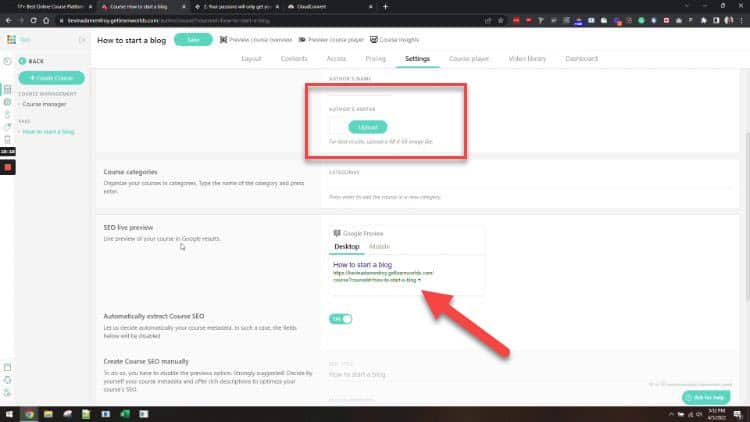
Customization is a great component of Learnworlds.
As soon as you start creating your course, you realize that the templates that are in place are easy to follow and you can quickly edit them to match your branding or the look of your website.
There’s also a focus on SEO, allowing you to optimize your courses for search engines so people can easily find them.
While it took some time to find a way to add media to specific lessons, once that was figured out it was a smooth process.
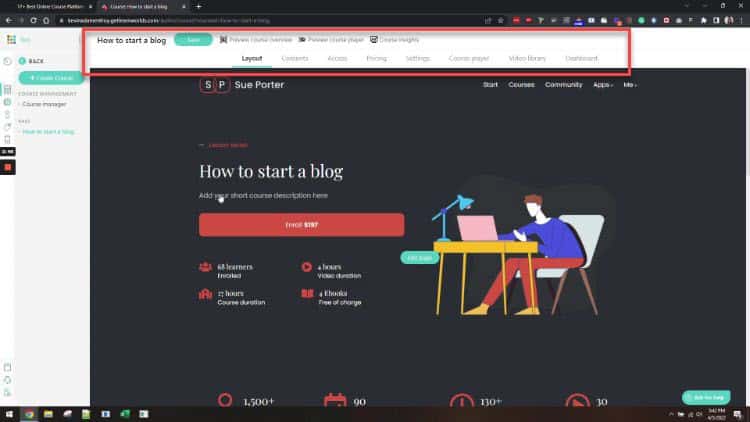
Pricing:
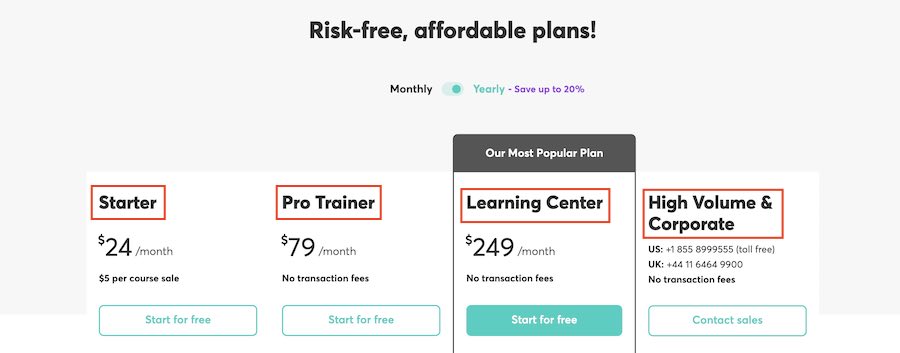
- Starter ($24/month paid annually): one admin, $5 fee per course sale, custom domain, unlimited courses, page builder tool, 4 payment gateways, coupons, and drip feed courses.
- Pro Trainer ($79/month): Starter features, plus no transaction fees, 5 admin accounts, subscriptions and memberships, custom checkout pages, live classes via Zoom and Webex, assignments, and affiliate management.
- Learning Center ($249/month): Pro Trainer features, plus a branded corporate academy, premium cloud servers, flexible invoicing, premium support, and a premium account manager.
What I Like/Dislike About Learnworlds:
Like:
- Interactive videos, e-books, gamification, and downloadable attachments.
- You can offer free courses.
- You can extract transcripts from your courses.
- A custom domain name and white-labeled content.
- Students can take notes and highlight important points.
- Certificates of completion.
- Custom mobile app on iOS.
- The ability to create coupons and discounts.
- Social media integrations.
- A new analytics platform to optimize your sales.
- The ability to create membership sites.
- A solid knowledge base.
- 24/7 support.
Dislike:
- No ability to get rid of site-wide features if you want specific customizations
- While there is the ability to change languages, it doesn’t work great.
Product Updates:
- Multi-Purpose Form Builder allows you to create custom forms for your courses. This can be anything from quizzes to surveys!
- New templates were introduced so that you have more choices and can quickly and easily create a professional-looking website without any design or coding experience required.
Get a free 30-day trial of Learnworlds with my link below and start building your interactive online community.
5. Podia.
Best For Hosting Communities ($33 per month).

Adam’s Take
If you want digital content to sell online, Podia could be a good platform for you. With options like selling courses and downloads, hosting webinars, and building a community, Podia can change based on your needs.
Podia is an all-in-one online course platform with over 50,000 members that is great for digital downloads, webinars, and memberships.
Its main types of courses include:
- Standalone courses that include images, video and audio files, MP3x, PDFs, quizzes, and more.
- Pre-sell your course by taking payments before launch.
- Cohort-based courses with a future start date.
- Drip courses deliver your course in a section-by-section format.
- The ability to add coupons and memberships.
They truly excel with their membership options. You can grow your online community by interacting with members, bundling products for specific groups, offering tiered plans, and connecting with Facebook Groups and Slack.
Podia also acts as a webinar platform to host either live or on-demand webinars.
Another excellent feature is the ability to run your affiliate program inside of Podia. You can view all of your affiliates in one place, view helpful reporting, and make payouts based on your customized commission structure.
There is 24/7 support, no transaction fees, and a simple three-step process to get your course website up quickly.
Finally, Podia also offers a free plan, allowing you to use their website builder to create a customizable website with your product.
With their community plan on this free option, you can offer your audience free or paid memberships, which is great to start building your list and selling a digital product.
Key Features:
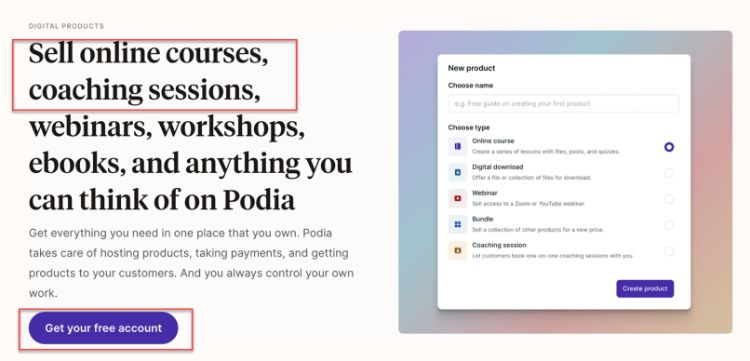
- Drip courses allow you to release your course content over time to keep your students engaged and coming back for more.
- Instant payouts mean you can get started with selling your courses right away.
- An all-in-one platform means you don’t have to juggle multiple tools to get your business off the ground.
- Connect your audience and content with tools like email marketing, landing pages, and social media integrations.
- Schedule and sell in advance with the ability to create courses open for enrollment only for a certain period.
- No transaction fees mean you keep more of your hard-earned profits.
User Experience:

Podia provides a straightforward interface when it comes to creating your courses.
You initially choose between the type of course that includes online courses, digital downloads, webinars, bundles, or coaching sessions.
After, you use their easy-to-understand menu to set up your course content.
The menu system gives you access to the needed features of each course creation stage, including adding text, audio, and video content.
You can also look at your audience, add coupons, look at affiliate and sales stats, and more.
Pricing:
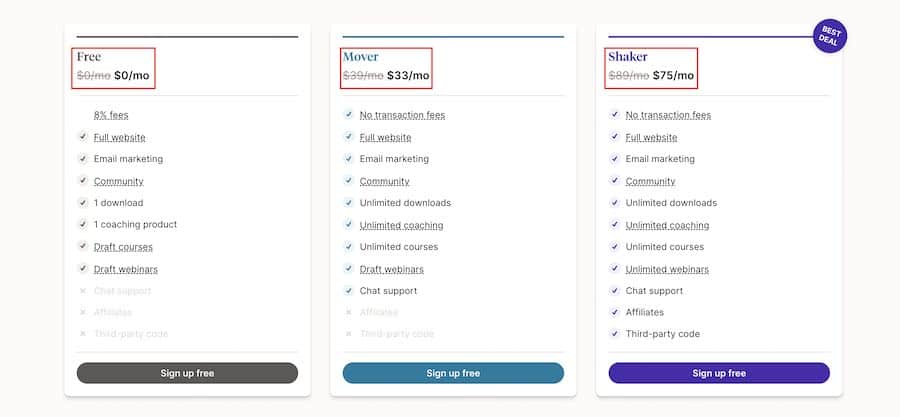
- Free Plan ($0/month) – Sell digital downloads or a coaching/consultation product and build your email list.
- Mover ($33/month) – Unlimited everything, zero transaction fees, sell courses, digital downloads, and 5k emails sent per month.
- Shaker ($75/month) – Everything in Mover, plus the ability to create membership communities, add affiliates, and have 15k emails sent per month.
What I Like/Dislike About Podia:
Like:
- The overall platform design allows for easy use by both those starting out and those with more experience.
- The user interface is simplistic and easy to navigate, making it straightforward for your students to find the courses they are looking for.
- Podia offers excellent value for money when compared to other platforms.
- The platform has been designed with the course developer in mind, making it easy to create and sell your courses.
- Since being launched, they have continually updated the platform with new features.
- Digital downloads are a great way to sell supplementary content to your students.
Dislike:
- The inability to categorize products means students can’t filter products on the storefront page.
- There is no way to add custom embed codes, allowing instructors to embed their courses on their websites/pages.
Product Updates:
- The community search and reporting feature improved, making it easier to search through your content and members. This means that finding and understanding your data is now a breeze.
- The newsletter section allows lead capture to start building your email list immediately.
- The Podia course viewer has been updated with a cleaner design, so your courses look their best.
Overall, suppose you’re looking for solid membership functionality and the ability to increase your sales with the help of affiliates. In that case, Podia is a unique and worthwhile course builder to try out.
You can sign up and give it a test run with their free plan.
6. Skool.
Best Simplified Experience.
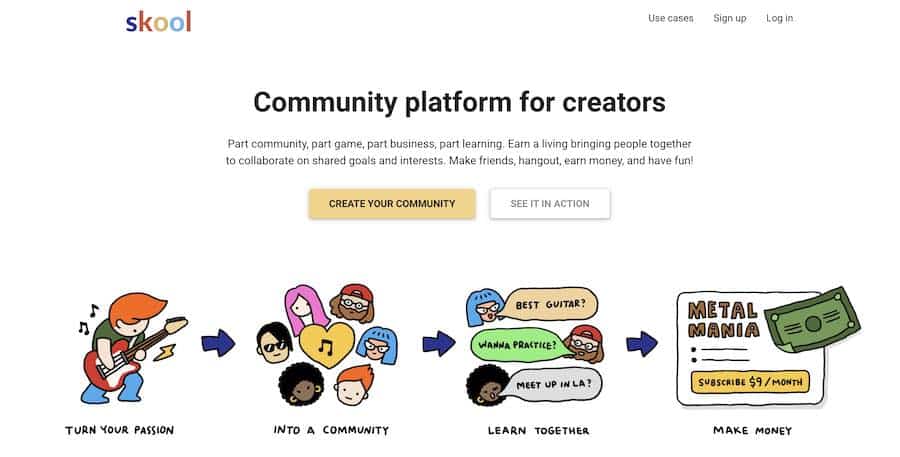
Skool brings everything you need to teach online courses into one easy-to-use platform.
With Skool, you can create and sell courses on any topic, build a community, track your student’s progress, and more.
Created initially to simplify online learning, Skool has become one of the most popular online course platforms.
With its user-friendly interface and features, it’s easy to see why.
Offering much more than a Facebook group when it comes to building a community, Skool has dedicated forums for each course where students can interact with each other and the instructor.
It’s easy for admins to create posts, ask questions through polls, share links and documents, and more.
If you’re looking for a simpler version of any current course platform out there, Skool is worth checking out.
Key Features:

- I like their community feature as it helps to bring everything you need to build a team in one easy-to-use platform.
- With Skool, you can create courses on any topic and easily track your student’s progress.
- The calendar feature is also beneficial in keeping track of any upcoming events you may have.
- I appreciate their email broadcast feature that allows you to send out updates to your students quickly.
- The chat, notifications, and profiles are also really helpful in keeping track of all the different people you’re working with.
User Experience:
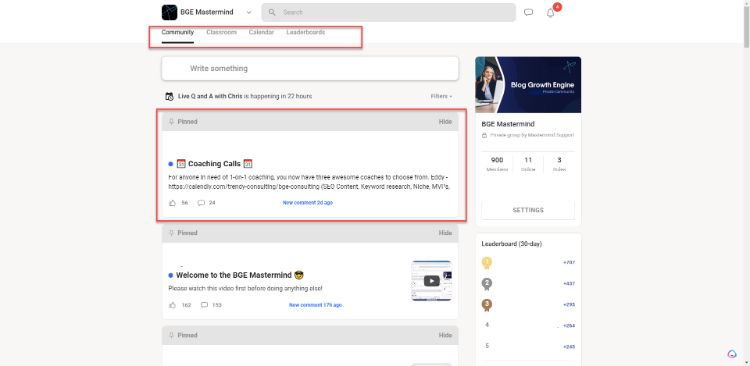
The platform is simple to navigate with the tabs located at the top of the page.
From your community, to the classroom, calendar, and more, everything is easy to find and use.
There are also the latest posts (plus the pinned ones) that show up when you first enter the site, which makes it easy to catch up on what’s been going on.
Pricing:

There is a 14 day free trial to get started. After that, there is a simple payment plan of $99/month that gives you access to all the features that Skool has to offer.
You can also book a demo to see if Skool is the right fit for you.
What I Like/Dislike About Skool:
Like:
- Skool is extremely user-friendly and easy to learn, providing an outstanding experience for users.
- A supportive and ever-growing community helps answer any questions you may have.
Dislike:
- Skool does not have its own video hosting capabilities, so you will need to utilize an external solution to host your videos.
Product Updates:
- You can now personalize your group by having custom-level names that are different from the standard “Beginner, Intermediate, and Advanced.”
- You can also provide various course to specific members when they get to a high level in your group.
Get started with Skool.
7. Mighty Networks.
Best For Creating Communities.
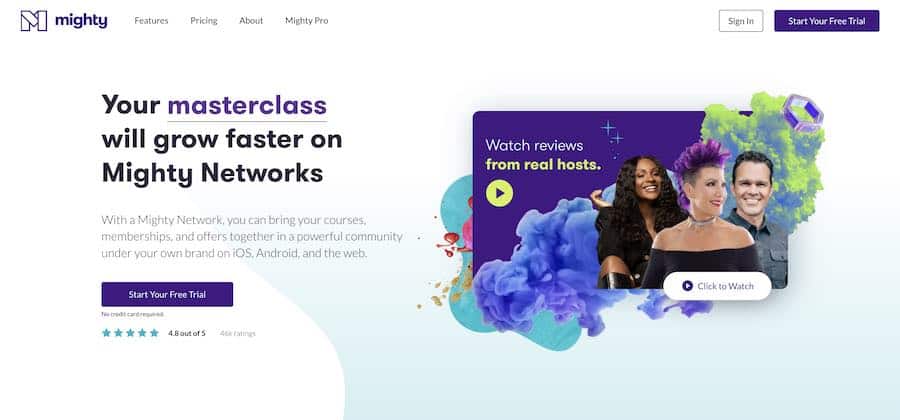
Mighty Networks allows you to build and own your online course, membership site, or the professional network—all in one place.
You can also use it to power your podcast, blog, or even your physical event space.
No matter what type of online course you want to create, Mighty Networks makes it easy to build and grow a thriving community around your course content.
You can also use your social media followers to build your Mighty Network—and reach a whole new audience of potential students.
Key Features:
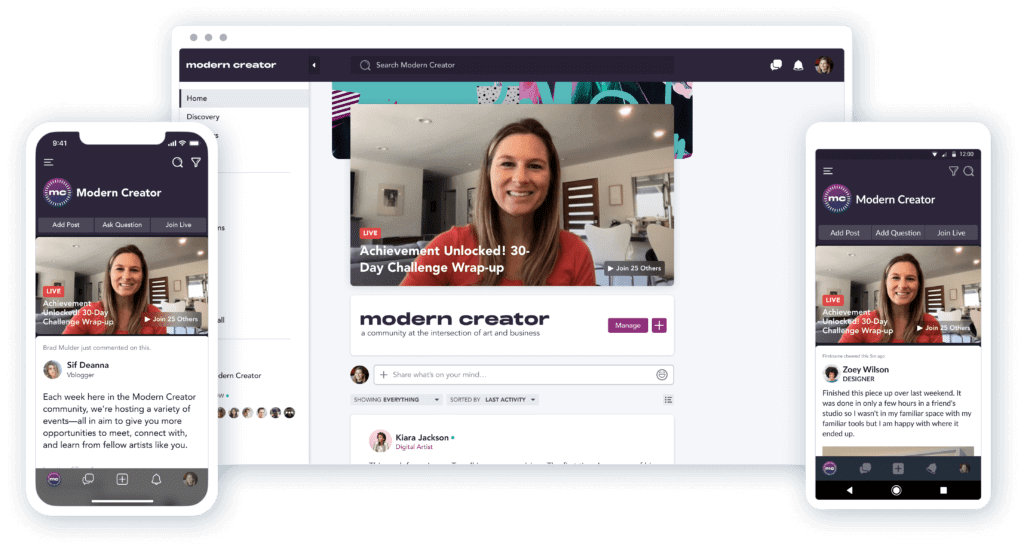
- You can live stream and upload your videos, a feature that is a game-changer for course creators.
- The Mighty Effect™ personalization technology ensures that every member of your Mighty Network sees content tailored just for them.
- The Welcome and Discovery sections make it easy for new members to find the content they’re looking for—and get started on your course.
- Unlimited members mean you can grow your network as big as you want without worrying about hitting a limit.
- Custom landing pages and domains let you brand your Mighty Network however you want, so it feels like home to your students.
User Experience:
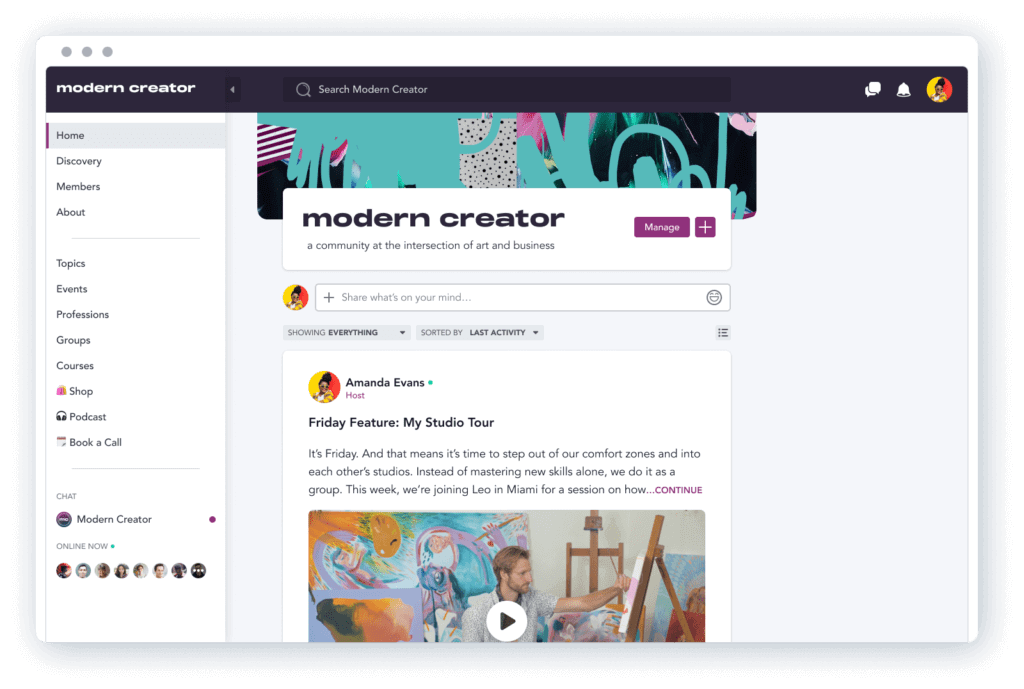
With an easy-to-use desktop and mobile interface, Mighty Networks is one of the most user-friendly online course platforms.
It’s simple to navigate and find the content you’re looking for—whether you’re a community member or an administrator.
Pricing:
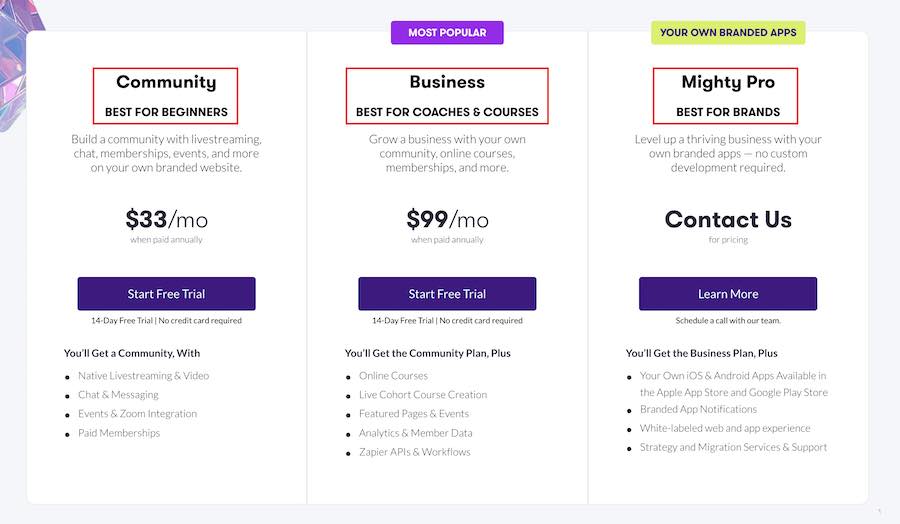
There are three pricing plans for those that want to create their online course on this platform:
- The Community Plan: $33
- The Business Plan: $99
- The Mighty Pro Plan: Request a demo to learn more about this.
What I Like/Dislike About Mighty Networks
Like:
- Clients can access their course via the mobile app downloaded from the Google Play Store or Apple Store.
- Creating an online system for a remote organization is easy to do.
Dislike:
- Integrating with some external payment systems takes a few clicks to get up and running.
Product Updates:
- Recent improvements to the member account creation flow make it easier for members to sign up for Mighty Network.
Get started with Mighty Networks.
8. LearnDash.
Great Online Course Software LMS for WordPress Users ($13.25/month)
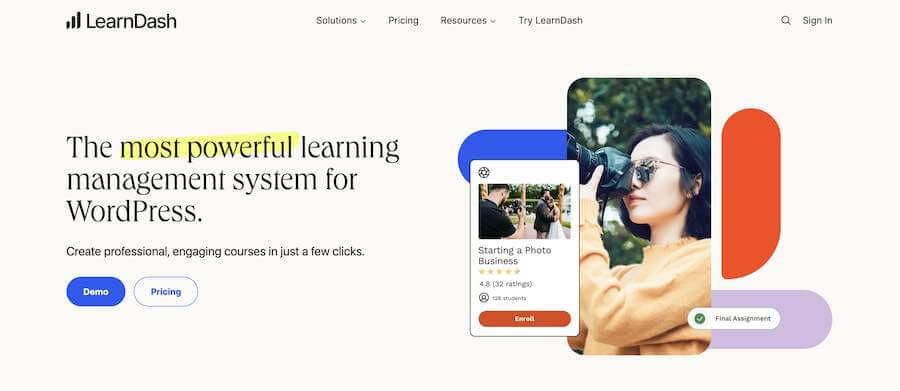
LearnDash is a WordPress plugin and the platform you need to sell courses with a WordPress site.
This popular WordPress LMS plugin is used by some big websites using LearnDash, including Yoast, Infusionsoft, the University of Michigan, and WP Elevation.
One of their first helpful features is their “Focus Mode,” which blocks out all distractions when students run through a course.
LearnDash’s full-featured course builder meshes well with their email drip campaigns. You can build a great online course on your website and match your content with an email drip schedule to send lessons according to a program.
Their Gradebook* technology takes LMS to another level.
This technology gives students an overall grade based on quiz and homework scores, creating a weighted average for teachers to review.
In addition to grading, course points award points for actions, and badges and certificates award students for course activities.
If you’re a teacher looking for grading systems that compete with the features of college curriculums, LearnDash is the best LMS plugin.
You can get started today with a $40 discount and a full 30-day money-back guarantee on their annual plans.
9. Ruzuku.
The Ridiculously Easy Online Course Platform ($74.75/month)

Ruzuku allows you to create a step-by-step online course with their learning platform, PDFs, and text in minutes.
You can quickly create course outlines, edit and reorder your steps easily, launch your course, and generate sales in no time.
Ruzuku integrates with tools like MailChimp, Infusionsoft and payment gateways like Stripe and PayPal to accept payments – and they don’t charge transaction fees.
They’re also known for their desirable community. When you join Ruzuku, you’re not buying a teaching tool; you’re joining a team to help your students learn.
Called “the ridiculously easy course creator,” Ruzuku comes with some excellent features listed below:
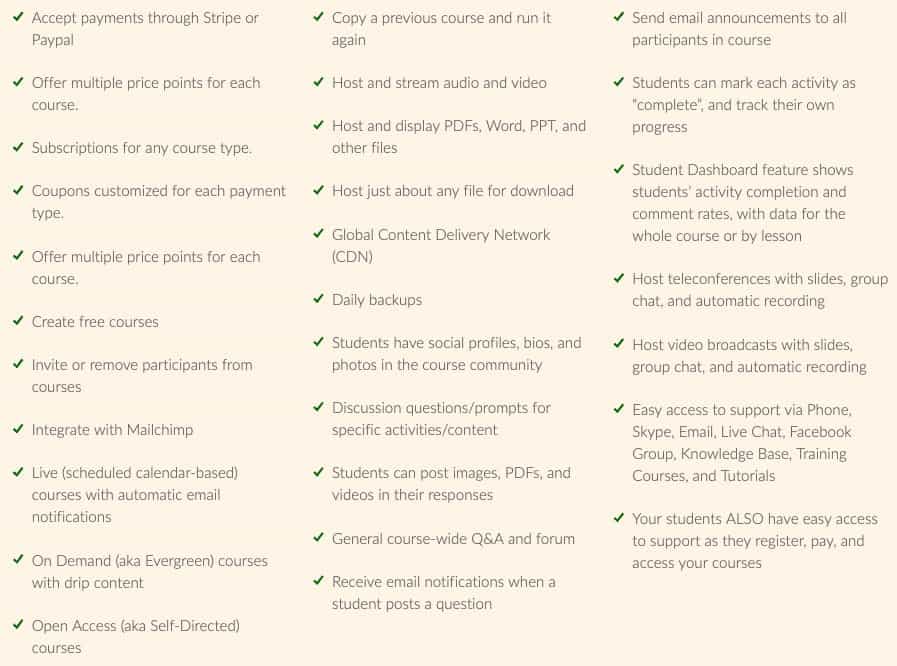
Finally, their platform offers unlimited courses to unlimited students on all paid plans.
You can get started with a 14-day free trial and 30-day money-back guarantee.
10. Academy of Mine.
The Enterprise Online Course Platform Custom-Built to Your Business ($499/month)
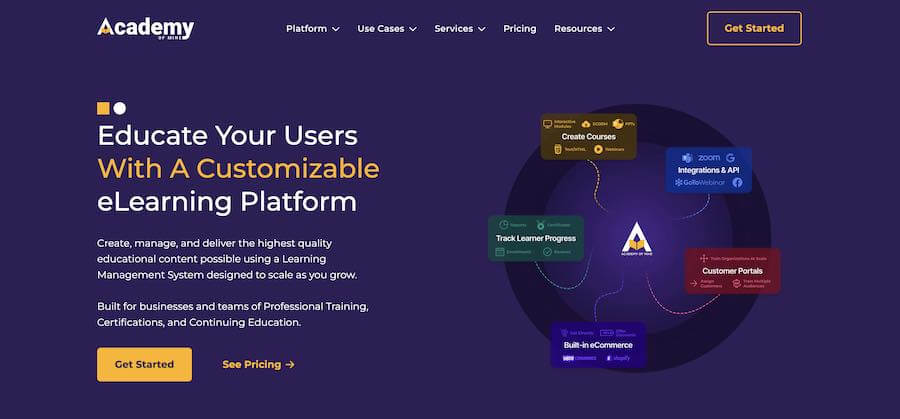
Academy of Mine is a high-end eLearning platform founded on personalized customer success and a philosophy of customization.
It’s truly a learning management system that works best in different business niches.
A standard plan feature is free development hours to help set up and launch your course with customized integrations.
One of their goals is not just to set you up and help you launch. They also want to help sell your course with their marketing tools and analytics dashboards.
Personalization is at the heart of its strategy.
Are you a healthcare company that wants to create a complete curriculum for continuing education credits (CECs)? They can help with that.
Are you an insurance company that requires continued training due to constant changes in a particular legal code at the state level?
Are you looking to create online courses to manage your facility?
That’s also no problem with Academy of Mine.
While these enterprise offerings may be overkill for typical users, they are necessary for small to medium-sized businesses needing a robust training system for their employees or clients.
If this sounds like the eLearning solution you’re looking for, you can get started today with their 30-day free trial.
11. WizIQ.
Affordable Live Virtual Online Classrooms ($27/month)
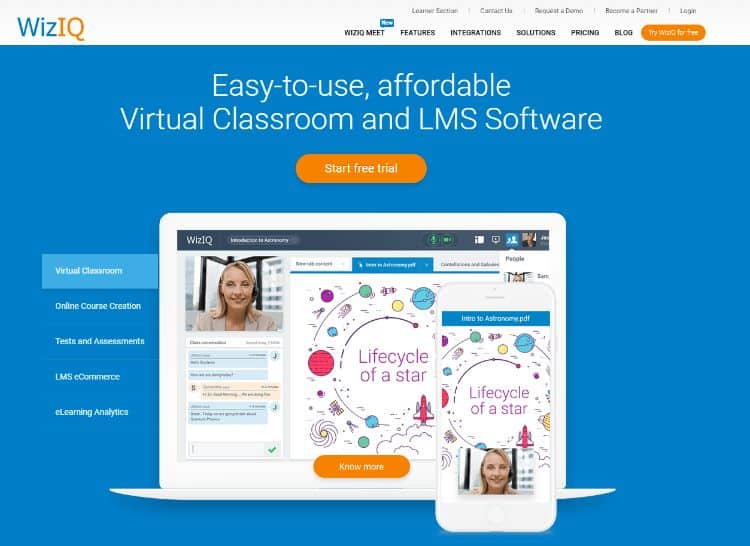
WizIQ offers teachers and educators an easy way to set up virtual classrooms for live interactive online classes.
Over 400,000 instructors have leveraged WizIQ to teach over 4 million students virtual classes across 200 countries.
They provide the latest tools for live training, such as discussion boards, video streaming, mobile options, assessments, and analytics.
If you are an educator or corporate leader that wants to reach your audience live anywhere in the world, you can get started with their 14-day free trial.
What Are Online Course Platforms?
Online course platforms are learning management systems (LMS) that give users access to digital classes. These virtual courses are similar to offline classes: an instructor provides an engaging educational experience through video, image, text, audio, and PDF files.
Students follow along with the LMS software, take notes, perform exercises, and complete exams to test their knowledge.
Tools like Teachable, Thinkific, Kajabi, Podia, and Ruzuku all feature a robust feature set for course creators.
Course software includes features like a fully responsive website experience, easy content uploading, the ability to edit the look and feel of the class, marketing features, course completion certificates, a sales funnel, and more.
They give you everything you need to sell an online course. Some even allow you to build your course for free.
If you’re an educational institution looking to replace your on-premise classes with online learning, it’s essential to understand the current best learning management systems (LMS).
Course creators choose a platform to use, then charge their students a set fee to access their courses.
What Are the Best Online Learning Platforms?
Now for the student’s point of view.
With social distancing becoming the norm and many colleges moving to online classes, there are plenty of ways to educate yourself from home.
Often called massive open online courses (MOOCs), they differ slightly from paid platforms. Instead of hosting files yourself, courses are in a marketplace where students pay for them directly or via a subscription.
The benefit for course creators is that you can leverage these websites to reach a new audience. The downside is you won’t earn as much money per sale, and there is stiffer competition in the market.
Ultimately, I recommend using one of the providers above to sell courses.
If you want to sign up for a platform to learn new things, here are my picks for the best online learning platforms.
1. Udemy.
Udemy is one of the best online course platform marketplaces with over 24 million students, 35,000 instructors, and unbelievable 80,000+ courses.
The first step to creating a course is signing up as a premium instructor.
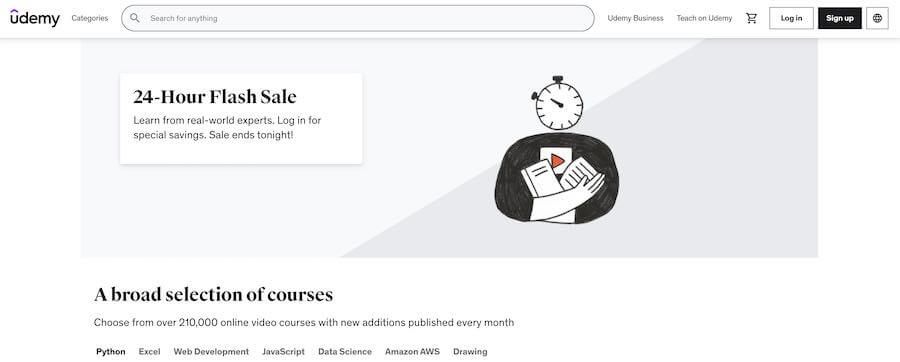
Once your account is approved, it’s effortless to start creating your courses. When creating your video content, remember that the material has to be at least 30 minutes long and contain five lectures.
Another benefit to adding your course on Udemy is that you can easily promote your class inside their platform.
You can use their marketing features to be included in site-wide discounts, be placed in their marketing emails, or join their affiliate program with tiered commission rates.
What does Udemy cost?
It is free to use.
They charge a 3% rev share for sales through instructor coupons, 50% for students who found your course through organic search (SEO), and 75% for transactions made through paid search marketing efforts.
Advantages
Udemy is one of the best online course platforms for professionals.
The first advantage is that you get access to a large user base. Udemy’s 40 million users are all potential students who will pay for your course.
But just because you’re on their platform doesn’t mean you’ll start raking in sales immediately.
You must develop a strong marketing and sales strategy, like a new e-commerce company, author, or real estate agent. It’s all about getting your name out there.
They provide a substantial revenue share for tuition fees.
Instructors set their course prices and receive revenue at 100% of the tuition fee for new users and 50% for existing users.
That’s a substantial commission on sales and a massive benefit to using their platform.
You can participate in their marketing promotions. Every so often, they run promotions that can help you reach a larger audience on their platform.
These marketing promotions are opt-in, so instructors can choose to participate.
They have reliable technology and support. They offer free 24/7 support, and they also have a vast library of helpful articles.
Disadvantages
There is intense competition with other courses.
Instructors are at the mercy of the placement and appearance on the Udemy website, which is controlled by their proprietary algorithms.
If you’re new to the platform, it can be difficult to outrank other instructors on particular topics.
There is also stiff competition with other course publishers. Udemy isn’t the only course marketplace ranking on search engines for your course topics.
Other marketplaces like iSpring Learn, LinkedIn Learning, Coursera, and Skillshare can compete with Udemy in organic search, which can disadvantage instructors.
They have lenient return policies.
Refunds are guaranteed to all students within 30 days for any reason.
Because of this, students could take a course, complete it within 30 days, and get a guaranteed refund – decreasing their sales.
Udemy Review: Final Verdict
First, they’re one of the most well-known, widely used, and professional online course marketplaces out there.
With a robust rev share model, a vast audience to tap into, 24/7 support, and marketing offerings, you can’t go wrong with their platform.
Although there is healthy competition with other course creators and platforms, the company will likely maintain its lead in the market.
Get started with Udemy for free today.
2. Shaw Academy.
Shaw Academy is a platform that gives its students access to professional, accredited online courses. Students sign up for Shaw Academy and get access to all of their long-form courses.

They offer courses in three distinct categories: for hobbyists, professionals, and entrepreneurs.
For example, their “For Professionals” category offers a globally-recognized Digital Marketing Course. This course includes 32 videos and takes an average of 16 weeks to complete.

What Does Shaw Academy Cost?
Courses are offered for free for the first four weeks.
You can then continue learning by paying for a monthly plan.
The cost then ranges from $49.99 to $60 per month.
Shaw Academy Pros
Their courses are all globally recognized and offer certifications to help your career. If you’re a working professional, their classes on digital marketing, project management, web development, Photoshop, and Microsoft Excel are very in-depth.
Entrepreneurs can also access helpful classes on social media marketing, viral marketing, wedding, photography, etc.
Their courses are all flexible, and you can complete them based on your schedule.
They also offer helpful support and the ability to download class recordings to watch them offline.
The four-week free plan is also a great bonus too.
Shaw Academy Cons
Although they offer many good courses, you may not find the right one depending on your industry.
They also don’t have the same volume of hobby classes as platforms like Skillshare.
Shaw Academy Review: Final Verdict.
If you’re a professional looking for flexible, accredited courses that you can start entirely free for four weeks, this platform is a great choice.
3. Skillshare.
Skillshare is a large marketplace focused on creative education. Topics include anything from graphic design and music production to fine art and cooking.

They also have classes on more technical topics like data science, analytics, and e-commerce. Skillshare has over 5 million users and has paid over $5 million to teachers.
Each class is 20-60 minutes broken down into shorter lessons, plus projects and a community discussion forum to connect with other students.
The open discussion is very beneficial for their creative topics, as students can share their progress and get feedback from others.
They also can help premium members with production and course planning and can even help with online course creation at their studio in New York.
What does Skillshare cost?
It is free for creating a premium course experience. They pay instructors $10 for paid membership referrals and monthly royalties for each minute of content watched.
Advantages
They have a large user base of creators and entrepreneurs.
If you offer content that suits a creative audience, Skillshare is a great platform to get noticed.
Lessons on web design, building your email list, photography, painting, personal branding, and creative topics are the most popular.
The quality of the classes is reliable.
They pride themselves on professional, high-quality courses. They can help outline your course based on the needs of their audience and can also assist with production.
Disadvantages
Earnings run through a royalty system. Each month, between 30 and 50% of Skillshare’s premium subscription revenue goes to a royalty pool for teachers.
The remaining funds go to marketing and promoting classes, supporting the platform, and running day-to-day operations. This royalty system works for well-established teachers, as the more minutes watched, the more revenue share you receive.
However, this makes it difficult for new instructors to receive much compensation when they’re just starting. Plus, students who watch at 2x speed only count as half the minutes toward the royalty pool.
Another disadvantage is they only offer email support. Although they have helped support articles, the only option to contact them is via email.
Skillshare Review: Final Verdict
Skillshare is an up-and-coming online course marketplace with over 4 million students. With a large user base of creators and entrepreneurs, it is an excellent option for instructors in creative fields.
Their classes are all high quality, and they can help ensure that your class will best match the needs of their audience for maximum impact.
However, based on the royalty system for earnings, and no live support, you may be able to make many more sales with a marketplace.
If you’re a creative course creator and want to reach a new audience, their online courses are worth a try.
Sign up with Skillshare and get two months of free classes.
4. LinkedIn Learning.

LinkedIn Learning (formerly Lynda) is another online course marketplace tailored to business professionals.
With over 1,000 business courses on project management, web development, and digital marketing, they’re an excellent platform for working professionals looking to keep their skills up-to-date.
They also offer certifications that you can add to your LinkedIn profile, showcasing your expertise and improving your online resume.
What does LinkedIn Learning cost?
Monthly fees tie to a premium LinkedIn membership, which is $29.99/month or $24.00/month if you pay annually.
Try LinkedIn Learning today and get one month free.
5. Treehouse.
Treehouse is a relatively new marketplace that believes in the democratization of education.
Their platform is “committed to making education accessible to students of all races, genders, sexual orientations, and socio-economic backgrounds.”
They feature 300+ technical courses on coding and development, over 50,000 students, and over 27,545 minutes of video (and counting).
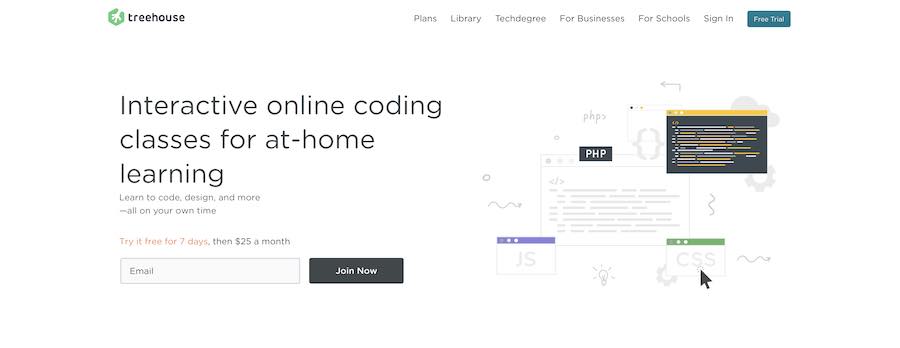
Treehouse partners with big names, including Microsoft, IBM Watson, Amazon Alexa, and Google Developers.
What does Treehouse cost?
Treehouse offers a 7-day free trial. Then you can choose from three monthly plans ranging from $25 to $199.
Their basic plan features on-demand courses, interactive practice sessions, and access to their online community.
The pro plan gives you access to bonuses, beta features, and downloadable content.
And if you’re looking to create a real portfolio and get job-ready skills, their Techdegree plan gives you personalized feedback, real-time support, and a custom curriculum.
Try Treehouse today.
6. Coursera.
Coursera is a professional online course marketplace with virtual classes from some of the world’s best companies and universities, like the University of Michigan, Duke, and Stanford.

Instructors teach Coursera courses at some of the world’s top universities, which take about 4-6 weeks to complete, and include video lectures, peer-reviewed assignments, and community discussion forums.
What does Coursera cost?
Coursera is free to join, and you must be logged in to see pricing information on individual courses. There are three tiers of class offerings at Coursera.
Main courses cost $29-99/month. These take the standard 4-6 weeks to complete, and you receive an electronic course certificate upon completion.
Specialization courses are for mastering a specific career skill and cost between $39-79 per month. In these online courses, you tackle real business challenges with hands-on projects and more rigorous coursework.
Online degree programs. If you’re looking for more advanced education, you can even participate in university-recognized online degree programs. These take 1-3 years to complete and cost anywhere from $15 to $25,000.
Give Coursera a try.
Other top platforms to take courses include ALISON and General Assembly.
How Do I Create and Sell Online Courses?
The first step to selling online courses is to start with your end goal in mind and work backward.
How will you transform your students’ lives, and how will they be different once they’ve completed your course?
You should start your course by planning the transformation your students will achieve.
To understand what your students want to learn, hang out in forums related to your topic, and look at the top questions people are asking. Quora is an excellent place for this.
Once you understand how to solve your student’s problems, create a clearly defined learning path to guide them to a predetermined goal.
During each stage of the course journey, make their outcomes clear.
By setting a learning path and clearly defined end goal, your students will stay more engaged and active with your content.
Here are the top 10 ways to create and sell online courses.
1. Figure Out the Cost of Developing Your Online Course.
The cost to develop your learning platform depends on many factors, including depth of content development, research and analytics expenses, and marketing. Studies estimate that a professional online course can cost between $5,850 and $15,600 to produce.
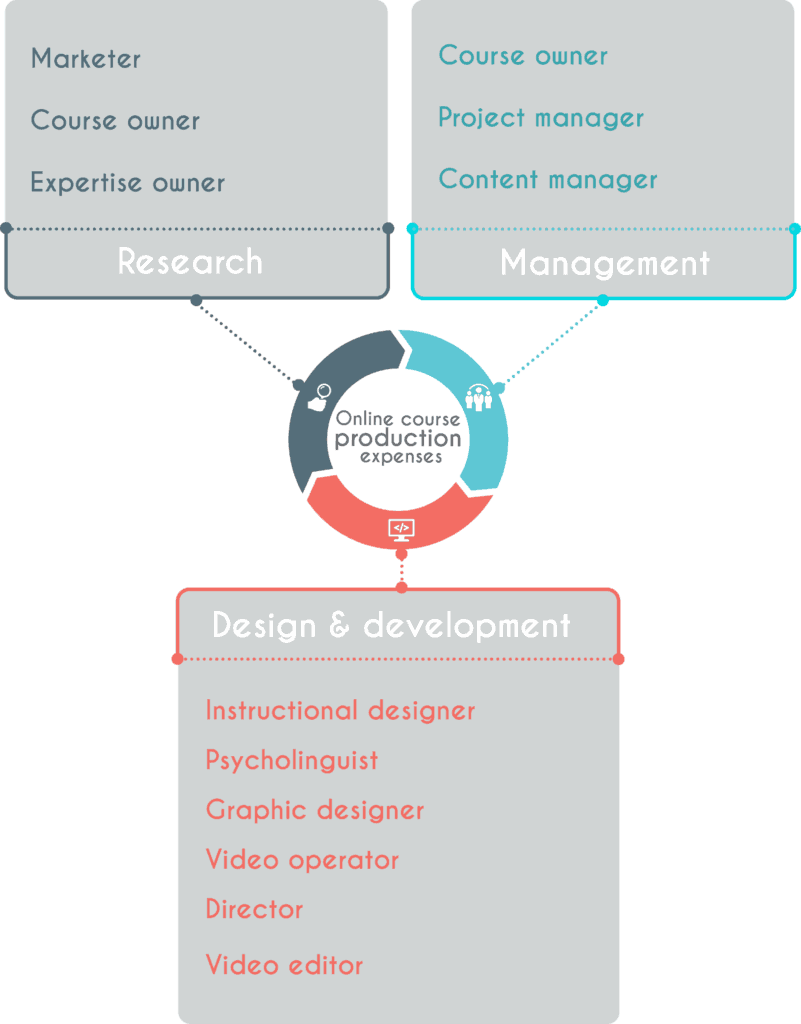
However, that’s a pretty high estimate, including professional video development, paying a subject matter expert (SME) to teach the course, market research, email automation or webinar software, and promoting the course. Source: racoongang.com
It can be much cheaper if you’re starting and want to create a course yourself.
For example, if you have a quality webcam, a microphone, screen-sharing tools, and video editing software, you can create a course for under $200.
Your most significant investment is time.
Keep in mind that online course costs rise with your effort.
The more effort you put into analyzing your audience, market research, creating an outline, and shooting professional media with an engaging instructor, the higher the cost.
2. Use the Best Software and Equipment.
Creating a course isn’t as simple as adding a webinar to a website. You need to produce the course first!
Software and equipment are required to create high-quality content.
Remember, you’re replacing an in-classroom experience with a virtual course, so it needs to look professional.

However, you don’t need the most expensive, high-end equipment to get started – but you will need a few essential items.
1. Microphones

Microphones are crucial. Bad audio is much easier to detect than shaky video, and you need a quality microphone for your course to sound excellent.
Use the best microphone you can afford. You can use a standard receiver, lavaliere mics, or a headset, but I recommend a USB microphone.
One of my favorites is the Blue Yeti. And don’t forget to get some microphone accessories to improve your audio quality further. Pop filters, foam balls, shock mounts, and acoustic panels are critical if you’re recording in a small room.
2. Headphones

A good set of noise-canceling headphones will help tremendously during the editing process. They also come in handy when conducting interviews and recording someone.
3. Screen recording program
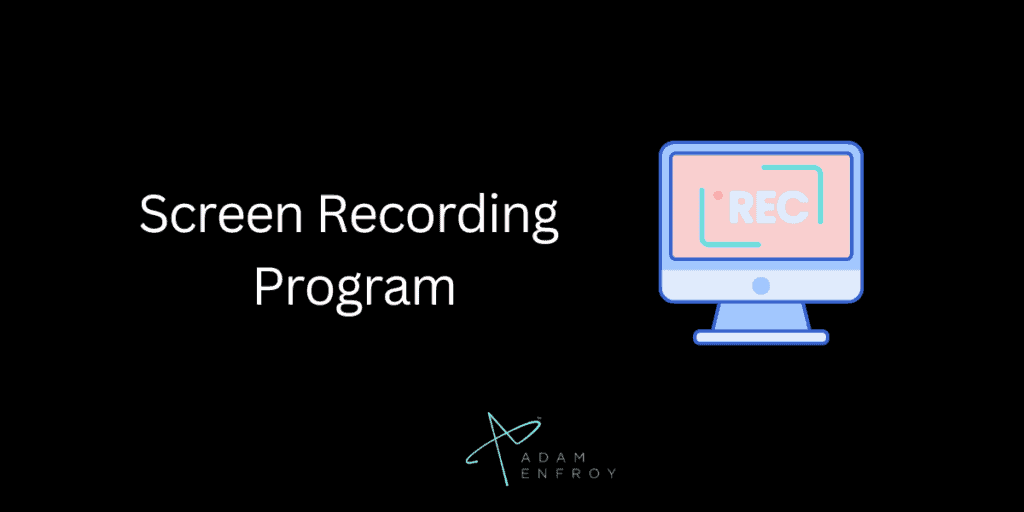
If you’re creating a class on a software or computer program, you’ll have to show the screen to highlight your work. There are many options for screen recording software, but one of my favorites is Screencast-o-matic.
4. USB Webcam
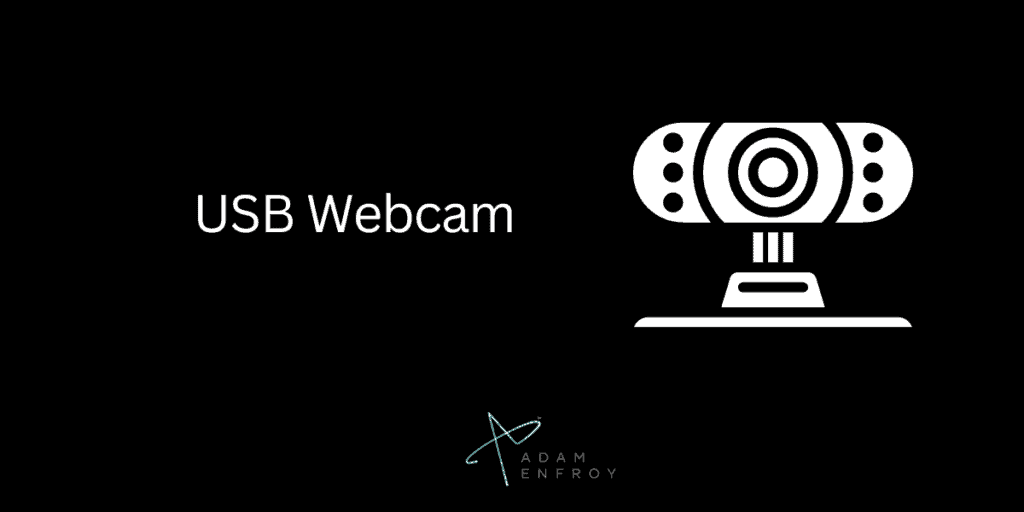
Mostly all online courses will require live webinars or videos of an instructor for a personal classroom feel.
Recording equipment can include something as simple as your iPhone, a webcam, or a run-up to professional DSLR camcorders.
The most significant factor is your budget.
5. Audio and video editing software
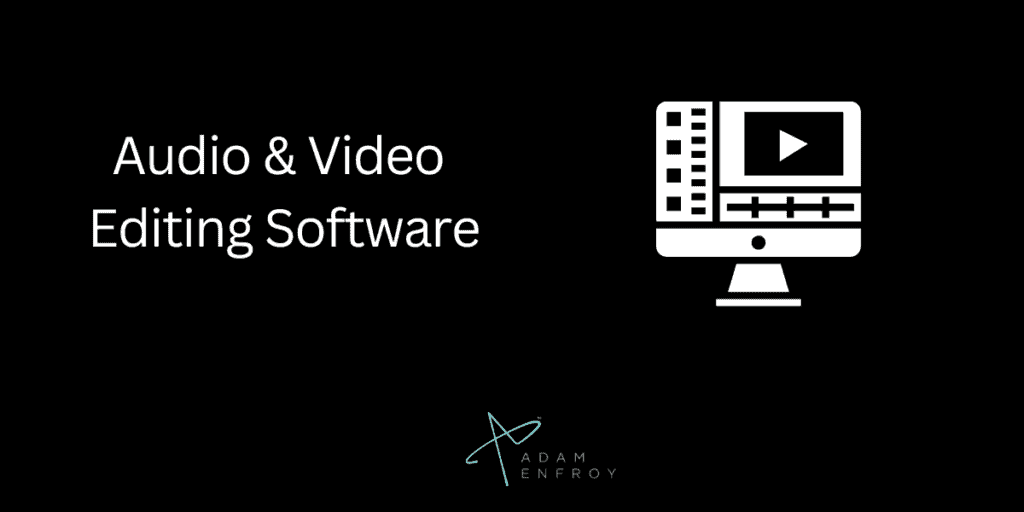
Once you’re done shooting your course, the real magic happens with editing.
My favorite options include Apple Final Cut Pro and Adobe Premiere Pro.
If you’re looking to spruce up your animations, try Adobe After Effects.
6. Lighting and accessories
Quality three-point lighting is crucial to ensure your instructor shines (pun intended).
You can purchase a complete studio light set or only some accessories for your iPhone.
Either way, you’ll want to research interview lighting techniques to certify you look professional.
3. Create Valuable Content.
This one is a no-brainer and is a common denominator when comparing online vs. classroom learning.
You need a detailed vision of who your ideal students are and what they are interested in learning.
Do they want to develop a new skill and earn an online certificate? Do they want to help grow their own business?
Understanding your audience’s pain points can create a vision for your course.
Create compelling video courses.
Use video plus interactive worksheets, PDFs, quizzes, and other elements to engage with your students on a deeper level.
Also, make sure to condense learning into shorter sentences – no one wants to read long paragraphs.
4. Differentiate Your Website.
Focus on your niche and provide the absolute best content with a focus on your unique value proposition (UVP). Unless you want to become the next EdX, you must specialize and be the best at an exceptionally focused niche.
Offer an exclusive hook statement and differentiate your course’s UVP out of the gate.
Ask yourself: What makes my course different than the rest?
For example, if your niche is graphic design, don’t create a course called “Graphic Design for Beginners.” That’s too broad.
A class called “Adobe InDesign for Ebook Publishers” is more focused and more natural to market.
Don’t focus on too many different areas.
Your online course should have one focal point and not stray away from it or go off-topic. You diversify into other topics after you see some initial success with your teachings.
5. Take Time to Market Your Business.
After pouring all of your hard work into creating your course, your job is just getting started. Now you need to market it.
You need a dedicated website.
You need a professional web presence to help people find you and view you as an expert in your field.
Your website should have an active blog with content related to your niche, which is search engine optimization (SEO) optimized.
Build a social media following.
Create your own Facebook Business page to engage with your community. Share your latest updates on Twitter and Instagram.
Having a regular post schedule and providing engaging social media content will help build a community behind your brand.
6. Have Control Over Your Brand.
Branding an online course platform is essential for any organization looking to offer courses and other educational content.
By branding the platform, your organization can create a unique identity that will help differentiate it from competing platforms, as well as attract potential customers.
The first step in branding an online course platform is to create a clear mission statement and vision.
This should define the course’s purpose, what topics are covered, why those topics are essential for learners, and who the target audience is.
The mission should be more than just a slogan; it needs to provide direction and purpose for the platform to communicate its value proposition effectively.
Once you have established your mission statement, it’s time to design the look of your platform.
This includes visuals such as logos, colors, fonts, images, and videos that will help create an attractive visual brand for your online courses.
Designing with these elements in mind will ensure that anyone accessing your courses has a positive experience from start to finish.
It’s also essential to consider how users interact with your platform when they access their courses or search for new ones.
Simplifying navigation can make it easier for learners to find what they need quickly and seamlessly move between coursework sections.
Additionally, establishing user guidelines and policies can help set expectations around privacy and security issues related to using the platform.
Finally, you’ll want to look into marketing options that can help promote your online course platform.
This could include creating promotional materials such as flyers or posters or investing in digital campaigns like pay-per-click advertising or targeted email campaigns.
7. Deliver an Exceptional Learning Experience.
The platform should deliver a great learning experience.
You should include multiple content types like audio, text, documents, and more.
Other features to look for include creating quizzes and sending completion certificates, forums, and “drip” courses sent to students over time.
8. Integrate with Other Tools.
Choose a platform that integrates well with other solutions.
You will want to ensure your learning platform can work with other tools like email marketing services, analytics solutions, and more.
Check for popular integrations with tools like MailChimp, Google Analytics, WordPress, and more.
For example, if you started a blog and are selling courses with a WordPress site, you need to choose a platform that can easily integrate into your current website.

If you do want to create an online course business with WordPress, you can search their plugin directory for a list of the right plugins:
9. Align Sales with Your Budget in Mind.
The platform should fit your budget and offer flexible pricing options. To make money selling online courses, you need to spend money.
But by looking into pricing information first, you better understand your potential return on investment.
You should also be on the lookout to see if any platforms charge a hidden transaction fee on your course sales.
When creating your online course and choosing an online learning platform, most paid plans remove heavy transaction fees.
10. Leverage Customer Support if You Need It.
The platform should offer excellent customer support and training.
Many services offer free resources and training, a dedicated account manager, and a helpful instructor community that can help you succeed.
Use those resources if you’re stuck – don’t be afraid to ask for help.
Summary and Top Picks
When choosing between the best online course platforms, remember to do your research: consider the student experience, marketing features, and pricing.
The best online course platforms let you easily upload your content, provide training for your students, and generate course sales.
All offer course creation tools and features for online teaching.
Ultimately, the critical factor is you.
The success of your course and the ability to sell courses online is based on the quality of your content and how well you can market yourself.
A platform is just that, a platform.
Yes, it’s a branded, engaging, interactive piece of media with your insights and experience, but it still needs planning, market research, development, and, most importantly, marketing.
Here are my final top picks:
- Thinkific: Best Overall Online Course Platform.
- Kajabi: Best for Professionals
- Teachable: Best For Beginners
With all of the high-end features you need at the most affordable price, Thinkific is the clear overall winner.
Ultimately, with endless topics to teach and millions of students ready to learn from you, why not get started today?
If you’re ready to start creating and selling online courses, I recommend you go with Thinkific.








No comments:
Post a Comment